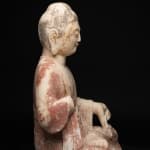Tang Marble Shakyamuni Buddha, 618 CE - 907 CE
Marble
50.8 x 35.6 cm
20 x 14 1/8 in
20 x 14 1/8 in
HK.2025a
Further images
-
(View a larger image of thumbnail 1
)

-
(View a larger image of thumbnail 2
)

-
(View a larger image of thumbnail 3
)

-
(View a larger image of thumbnail 4
)

-
(View a larger image of thumbnail 5
)

-
(View a larger image of thumbnail 6
)

-
(View a larger image of thumbnail 7
)

-
(View a larger image of thumbnail 8
)

This is a marble sculpture of the Buddha Shakyamuni. He has a broad face, with plump cheeks and a round chin, coherent to the classical Tang style. The colour red...
This is a marble sculpture of the Buddha Shakyamuni. He has a broad face, with plump cheeks and a round chin, coherent to the classical Tang style. The colour red on his sanghati and black of his hair are well preserved, while showing reasonable traces of aging. The subtle spots of gold on its chest unveils the distinctive practice of the Sui-Tang period, where the flesh part of a Buddhist sculpture are often gilded with gold.
Marble is also known as “Han white jade” in China. In Chinese tradition, jade symbolises virtue and loyalty. Therefore, using marble to depict venerable Buddhist figures is a material way to pay respect to the deities. Such practice started from the Northern Dynasties period, when the nomadic tribes conquered China and established their sinicised states, while in the process they brought Buddhism to China from the West.
In Buddhist art, a common way to construct a scene is to adopt the “1+2” mode, which puts the main figure at the centre and two disciples or subsidiary figures on its two sides. It is extremely rare to have a complete set of a trio since many of them have separated along the ages, rendering this Tang marble trio even more precious.
Marble is also known as “Han white jade” in China. In Chinese tradition, jade symbolises virtue and loyalty. Therefore, using marble to depict venerable Buddhist figures is a material way to pay respect to the deities. Such practice started from the Northern Dynasties period, when the nomadic tribes conquered China and established their sinicised states, while in the process they brought Buddhism to China from the West.
In Buddhist art, a common way to construct a scene is to adopt the “1+2” mode, which puts the main figure at the centre and two disciples or subsidiary figures on its two sides. It is extremely rare to have a complete set of a trio since many of them have separated along the ages, rendering this Tang marble trio even more precious.







